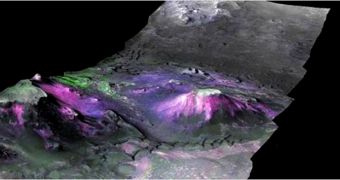During a period of time extending from 3.7 to 3 billion years ago, the Martian surface was dotted by lakes made up of liquid water, most likely originating in melted ice. The new study that came to these conclusions proposes that this is a significant finding for the development of life on the planet.
Long ago, the Red Planet was surprisingly similar to our own. The ice currently stored at its poles was spread in liquid form around the surface, forming ponds, lakes, deltas, flowing streams, and maybe even an ocean, as some studied suggest.
Average temperature levels were also significantly higher than they are today, and the planet even had an atmosphere that carried out several chemical cycles of its own. These phenomena are now gone.
But, back then, conditions were ripped for the development of life. If the emergence of organic materials, and then of basic microorganisms is dependent on liquid water, high temperatures and a comfortable climate, then it's possible life appeared on our neighboring planet too.
Today however, all of these potential lifeforms are either gone, or have adapted to living underground. They cannot be readily detected on the surface. Yet, the NASA Viking missions may have found the first signs of Martian biology in 1976 and 1977, respectively.
Studies conducted on those samples by NASA researchers yielded mixed results. Even the space agency first confirmed having found signs of Martian life, only to revise its official position when other studies failed to find anything. That debate is still ongoing now, four decades later.
“If we can go to Mars and find evidence of past life, then we will have proven that the development of life from chemistry is a general phenomenon in the Universe,” Mars Society founder Robert Zybrin tells Discovery Magazine in a new interview.
The study showing that Mars may have had 20-kilometer wide lakes in some of its equatorial regions was conducted by British researchers at the Imperial College London (ICL) and the University College London (UCL).
The team proposes that most of the channels which were discovered on Mars were carved out by water that burst out of these lakes as their levels increased above the banks.
“We can now model the 3D shape of Mars' surface down to sub-meter resolution, at least as good as any commercial satellite orbiting the Earth. This allows us to test our hypotheses in a much more rigorous manner than ever before,” says expert Jan-Peter Muller.
He holds an appointment as a professor at the UCL Department of Space Climate Physics Mullard Space Science Laboratory.
“If life will develop wherever it has a decent planet, it means that the Universe is filled with life. And if life is everywhere, it means intelligence is everywhere. It means we're living in an inhabited Universe,” Zubrin explains.
“This is something that thinking men and women have wondered about for thousands of years, and we can find out the answer to this if by going to Mars,” he concludes.

 14 DAY TRIAL //
14 DAY TRIAL //